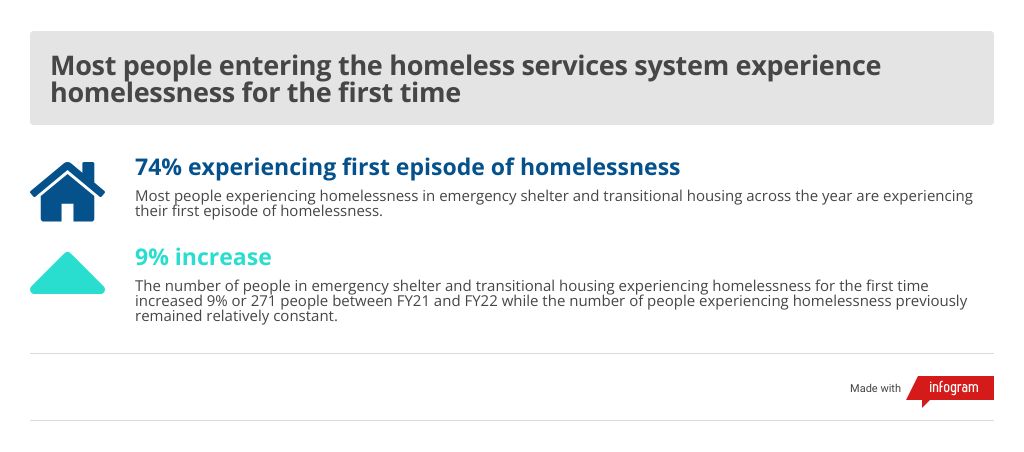HUD SYSTEM PERFORMANCE MEASURES:
NUMBER OF PEOPLE WHO BECAME HOMELESS FOR THE FIRST TIME
Mary Ann Priester
Senior Management Analyst
Mecklenburg County Community Support Services
The McKinney-Vento Homeless Assistance Act requires Continuums of Care (CoCs) to assess their efforts in addressing homelessness. To fulfill this obligation, the Department of Housing and Urban Development (HUD) has outlined seven System Performance Measures. Annually, Charlotte-Mecklenburg must submit reports on six of these measures to HUD. These measures are crucial for securing CoC funding and serve as important instruments for local monitoring and system improvement. This blog is the fifth installment in a series exploring Charlotte-Mecklenburg’s performance on these measures and their implications for the local community.
In this blog post, we offer an overview and present data on System Performance Measure Five: Number of People Who Became Homeless for the First Time.
SYSTEM PERFORMANCE MEASURES
The HUD System Performance Measures offer a comprehensive assessment of community efforts to prevent and end homelessness. They go beyond just tracking the reduction in homelessness numbers and also gauge the effectiveness of the coordinated system in ensuring homelessness is rare, brief, and non-recurring. These measures include:
System Performance Measures include:
- Length of Time Persons Remain Homeless
- Returns to Homelessness Within 24 months
- Number of Homeless Persons
- Employment and Income Growth for CoC funded projects
- Number of People Who Become Homeless for the First Time
- Prevention and Housing Placement for Persons Defined by Category 3
- Successful Placement in or Retention of Permanent Housing
This blog series provides a deep dive into each measure, explains the desired outcomes, what is being measured, and who is included. Previous blogs have focused on Length of Time Homeless, Returns to Homelessness Within 24 Months, Number of Homeless Persons, and Employment and Income Growth for CoC Funded Projects. This blog will focus on the fifth measure: Number of People Who Became Homeless for the First Time .
FOCUS ON MEASURE 5: NUMBER OF PEOPLE WHO BECAME HOMELESS FOR THE FIRST TIME
Measure 5: Number of People Who Became Homeless for the First Time, examines change in the number of people entering the homeless system through emergency shelter, safe haven, or transitional housing (measure 5.1) or the change in the number of people entering the homeless system through emergency shelter, safe haven, transitional housing, or permanent housing (measure 5.2), who have not had any prior enrollments in HMIS in the previous two years. Individuals who have not had an enrollment in the past two years are considered to be experiencing homelessness for the first time.
For federal fiscal year, FY 22 (October 1, 2021-September 30, 2022) in Charlotte-Mecklenburg, of the 4440 people who entered emergency shelter, safe haven, or transitional housing, 3284 were experiencing homelessness for the first time. That is, 74% of people who entered these types of projects were experiencing homelessness for the first time. In FY21, 69% of the 4347 people who entered emergency shelter, safe haven, or transitional housing were experiencing homelessness for the first time.
Among the 5369 persons who entered emergency shelter, safe haven, transitional housing, or permanent housing in FY 22, 70% (3758) were experiencing homelessness for the first time. In FY21, 67% of the 5090 persons who entered emergency shelter, safe haven, transitional housing, or permanent housing were experiencing homelessness for the first time.
These data suggest that not only were more people served through emergency shelter, safe haven, transitional housing, or permanent housing projects, but the number of people who were served by these projects and were experiencing first time homelessness has increased. It is important to note that increases in first-time homelessness may be due to the expiration of pandemic-era protections and resources, a lack of affordable housing, and a lack of tenant protections. These increases may point to a need for an enhanced prevention system and an increase in prevention assistance (both financially and through tenant protection efforts). These data might also point to the need for more targeted upstream efforts such as income support and employment training programs. Strengthening social safety nets by providing robust income support programs such as unemployment benefits, housing vouchers, and cash assistance for low-income individuals and families and increasing the minimum wage to a living wage can improve financial stability and prevent homelessness. Investing in job training programs, education initiatives, and workforce development initiatives can improve access to stable employment and higher-paying jobs and reduce the risk of homelessness.
SO WHY DOES THIS MATTER?
Analyzing system-level data is essential for effective local care systems addressing homelessness and housing instability. The HUD System Performance Measures offer a framework for this crucial assessment. Fewer people experiencing first time homelessness is the desired outcome for System Performance Measure 5. Preventing first-time homelessness requires a comprehensive approach addressing systemic issues and individual needs. Strategies include affordable housing initiatives, income support programs, employment opportunities, early intervention services, prevention programs, community support networks, and education and awareness efforts. By implementing these strategies collaboratively, we can create more inclusive and resilient communities and work towards preventing homelessness for all.


